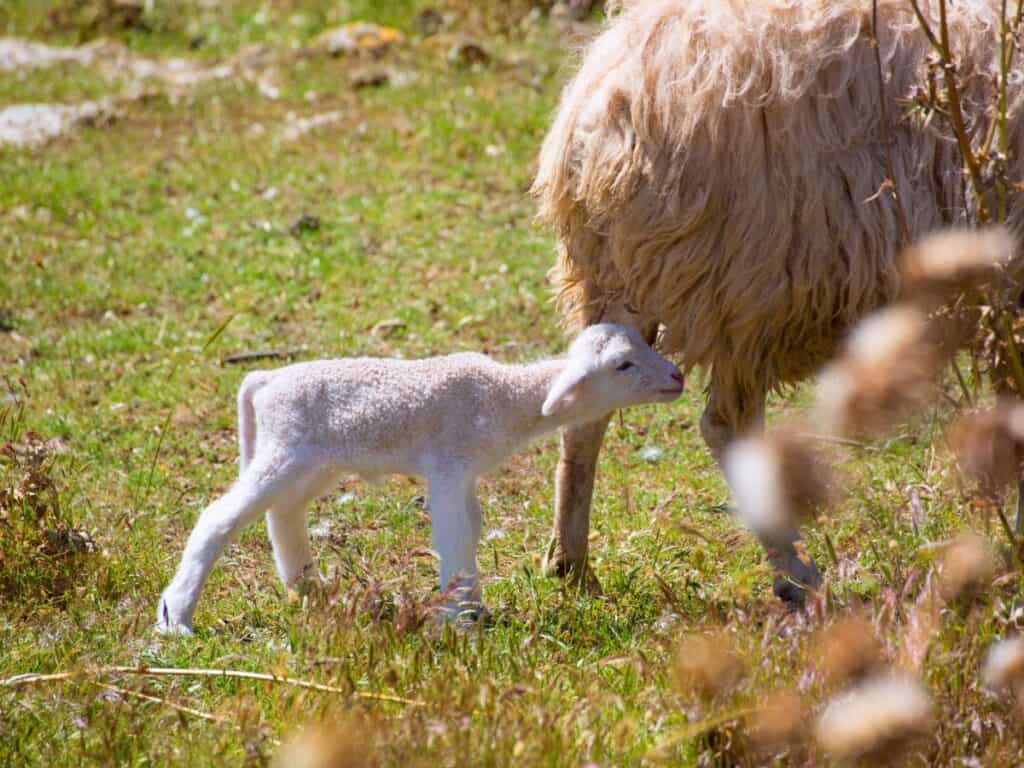As a sheep farmer, I often get asked what a baby sheep is called. Well, the answer is quite simple: a baby sheep is called a lamb. Lambs are adorable, fluffy creatures that bring joy to any farm. They are the offspring of ewes and rams, and are considered lambs until they reach one year of age.
It’s important to note that there are different terms used to describe a baby sheep depending on their gender and reproductive status. A male lamb is called a ram lamb, while a female lamb is called an ewe lamb. If a male lamb is castrated, it is then called a wether. Additionally, a female sheep that has not yet given birth is called a ewe, while a female sheep that has given birth is called a dam. Understanding these terms is crucial for any sheep farmer or enthusiast.

Understanding Sheep Terminology
As someone who works with sheep, it’s essential to understand the terminology used to describe different types of sheep. In this section, I will describe the three main terms used to describe baby sheep: lamb, ewe, and ram.
Lamb
A lamb is a baby sheep that is less than one year old. It can be either male or female. Lambs are typically born in the spring and are usually weaned from their mother’s milk at around three to four months old. They are often sold for meat when they reach a weight of around 100 pounds.
Ewe
An ewe is a female sheep that is over one year old. Ewes are used for breeding and can give birth to lambs once a year. They can be bred until they are around six to seven years old. Ewes are typically smaller than rams and have shorter, finer wool.
Ram
A ram is a male sheep that is over one year old. Rams are used for breeding and can mate with multiple ewes. They are typically larger than ewes and have longer, coarser wool. Rams can be aggressive during breeding season, so it’s important to handle them with care.
Understanding the terminology used to describe sheep is crucial for anyone who works with them. By knowing the difference between a lamb, ewe, and ram, you can ensure that you are providing the right care for each animal.
Life Cycle of a Sheep
Birth
When a female sheep, also known as a ewe, becomes pregnant, she carries her offspring for about 145-150 days. The process of giving birth to a baby sheep is called lambing. Baby sheep are called lambs, and they are usually born in the spring. Ewes typically give birth to one or two lambs at a time, although sometimes they may have triplets or even quadruplets.
Juvenile Stage
After birth, lambs depend on their mother’s milk for nutrition. They start to eat solid food after a few weeks, and they continue to nurse for several months. During this time, they grow quickly and gain weight rapidly. Lambs are weaned from their mother’s milk when they are around 3-4 months old.
Adulthood
As lambs mature, they become known as sheep. They reach sexual maturity at different ages depending on their gender. Ewes generally reach sexual maturity at around 6-8 months old, while rams reach maturity at around 4-6 months old. Sheep are social animals and often live in flocks. They graze on grass and other vegetation and can be found in many different environments, from pastures to mountains.
Sheep have a lifespan of around 6-14 years, depending on their breed and living conditions. During their lives, they may go through several lambing cycles and produce offspring of their own. Overall, the life cycle of a sheep is a natural and fascinating process that plays an important role in agriculture and animal husbandry.
Sheep Breeding
Breeding sheep can be a complex process that requires careful attention to detail. As a sheep farmer, I need to ensure that my ewes are in good health and ready for breeding. I also need to consider the genetics of my flock and choose a suitable ram to breed with my ewes.
When it comes to breeding, sheep are seasonally polyoestrus animals. This means that ewes go through oestrus cycles every 17 days or so, which last for approximately 30 hours. During this time, the ewe is receptive to the ram and can become pregnant.
As a farmer, I need to carefully monitor my ewes during their oestrus cycles to ensure that they are bred at the right time. If a ewe misses her oestrus cycle, she will need to wait until the next cycle to breed. This can delay the breeding process and impact the overall productivity of my flock.
When selecting a ram to breed with my ewes, I need to consider a range of factors. These include the ram’s genetics, temperament, and overall health. I also need to ensure that the ram is compatible with my ewes and that he is able to produce healthy offspring.
Breeding sheep can be a challenging but rewarding process. By carefully selecting my breeding stock and monitoring my ewes during their oestrus cycles, I can ensure that my flock is healthy and productive. With the right approach, breeding sheep can be a profitable and enjoyable experience for any farmer.
Sheep in Agriculture
Sheep are one of the oldest domesticated animals in the world and have been used in agriculture for thousands of years. As a livestock animal, sheep are raised for their meat, milk, wool, and hides.
In agriculture, sheep are often raised on pasture or range land, but they can also be raised in feedlots. Sheep can graze on a variety of plants and are often used to control weeds and brush in pastures.
Sheep are also used in rotational grazing systems, which help improve soil health and reduce erosion. In these systems, sheep are moved from one pasture to another to allow the land to rest and recover.
Sheep are an important part of many agricultural economies around the world. In addition to providing meat, milk, wool, and hides, they also provide fertilizer for crops. Sheep manure is high in nitrogen, phosphorus, and potassium, making it an excellent fertilizer for crops.
Overall, sheep are a versatile and important part of agriculture. They provide a variety of products and services, and are an important part of many farming systems around the world.
Sheep in Culture and Religion
Sheep have played a significant role in various cultures and religions throughout history. Here are a few examples:
- In Christianity, sheep are often used as a metaphor for followers of Jesus Christ. In the Bible, Jesus is referred to as the “Good Shepherd” who lays down his life for his sheep (John 10:11). Sheep are also mentioned in numerous parables, such as the Parable of the Lost Sheep (Luke 15:3-7).
- In Islam, sheep are highly valued for their meat and wool. During the Islamic holiday of Eid al-Adha, Muslims around the world sacrifice sheep as a symbol of Abraham’s willingness to sacrifice his son for God.
- In ancient Greek mythology, the god Apollo was often depicted as a shepherd, and his sacred animal was the sheep. The Greek hero Jason and his crew, the Argonauts, were tasked with retrieving the Golden Fleece, which came from a magical sheep.
- In Chinese culture, the Year of the Sheep is one of the 12-year cycle of animals that make up the Chinese zodiac. People born in the Year of the Sheep are said to be gentle, compassionate, and artistic.
- In many cultures, sheep are associated with sacrifice and atonement. In Judaism, sheep were often used as offerings to God in the Temple. In ancient Rome, sheep were sacrificed to the gods as a way to ensure fertility and prosperity.
Overall, sheep have played a significant role in the history of human civilization, and continue to be an important part of many cultures and religions around the world.
Frequently Asked Questions
What is the name for a baby sheep?
A baby sheep is called a lamb.
What do you call a young sheep?
A young female sheep is called a ewe lamb, and a young male sheep is called a ram lamb.
What is the term for a newborn sheep?
A newborn sheep is called a lamb.
What is the proper name for a lamb?
The proper name for a lamb is a young sheep that is less than a year old.
What is the term for a juvenile sheep?
A juvenile sheep is called a hogget or a shearling.
What is the name for a sheep that is less than a year old?
A sheep that is less than a year old is called a lamb.
